Check out our range of stock.
Didn't find what you like?
Send us a message
Found something out of stock?
Send us a message
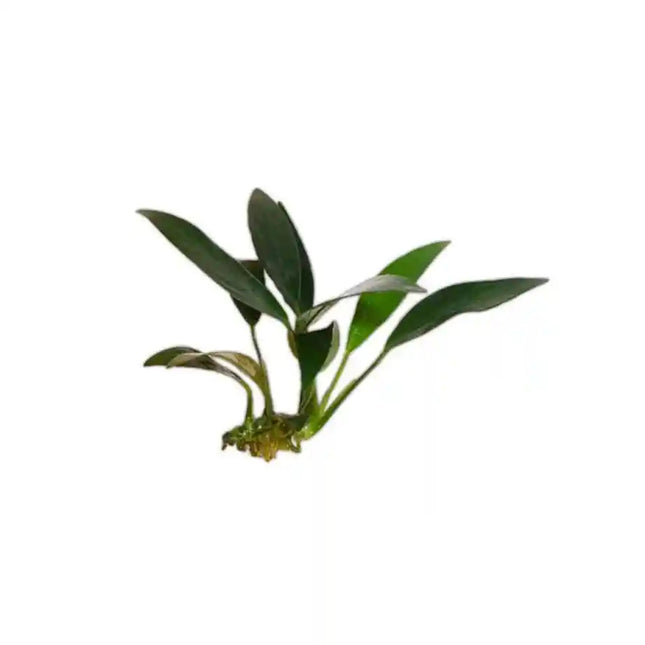
Narrow-leafed, medium-sized AnubiasCharacteristics: plant with stolonLeaf-stem: up to 20 cmLeaves: 13–35 cm long, 3–13 cm broadHeight in aquarium: 25 – 30 cmOptimal conditions: Temperature: 22 – 28 °CpH: 6.0 – 7.0Water hardness: 2 dGH – 6 dGHPosition in aquarium: middle to backUsual growth rate: one leaf every 2 months
$10.00
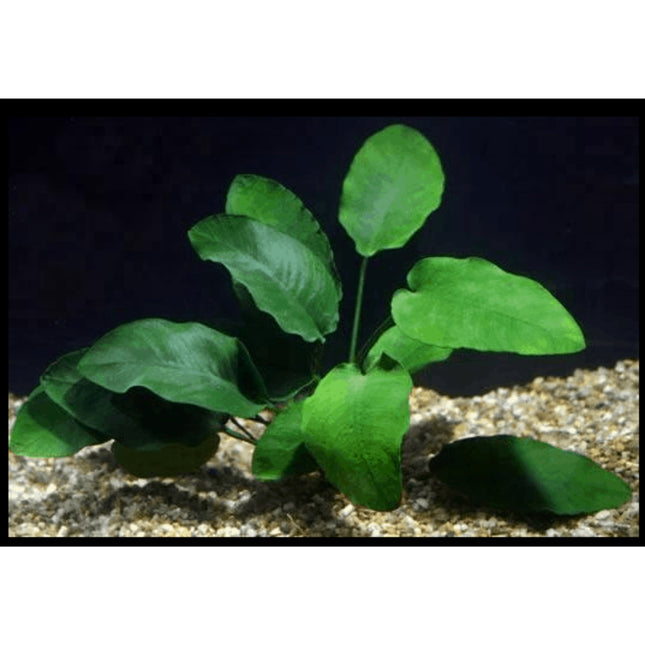
Compact, heart-shaped anubiasLeaf-stem: up to 23 cmLeaves: 7–23 cm long, 4–11 cm wideHeight in aquarium: 25 – 45 cmOptimal conditions: Temperature: 20 – 27 °CpH: 5.5 – 9.0Water hardness: < 20 dGHPosition in aquarium: backUsual growth rate: one leaf every 3 months
$39.95
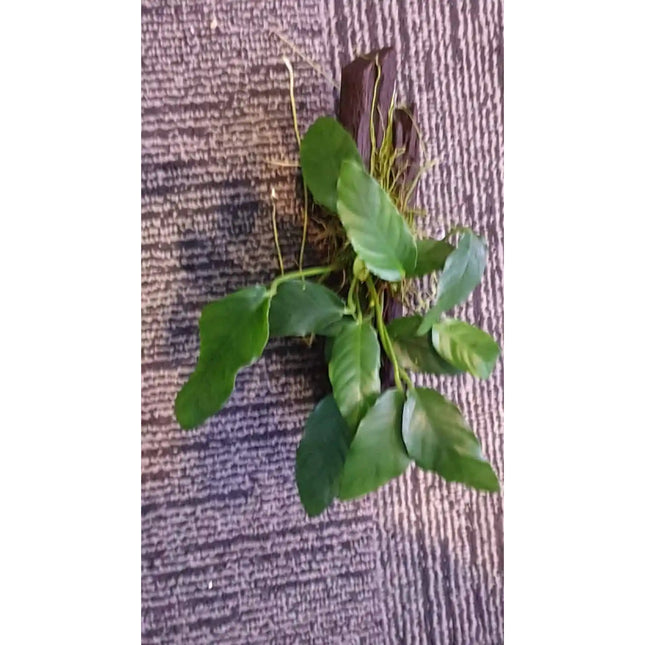
Anubias barteri on driftwood is a beautiful aquatic plant with dark green, heart-shaped leaves growing on a piece of driftwood. The leaves are thick and leathery, making them very hardy and able to withstand a wide range of conditions. The combination of the dark green color of the leaves and the natural texture of the driftwood make for a stunning display in any aquarium. Anubias barteri is easy to care for and can thrive in a wide range of water parameters, making it an ideal choice for beginners and experienced aquarists alike. It is best to attach Anubias barteri to the driftwood with cotton thread or fishing line as it can be easily removed for maintenance. It is a low-light plant, making it suitable for many aquariums, and it does not require any fertilizers or other additives to thrive.
$39.95
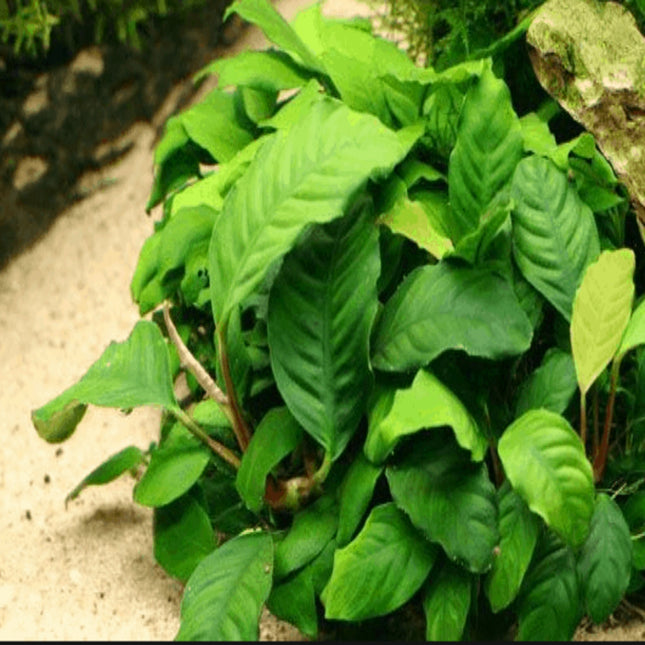
Narrow-leafed, medium-sized Anubias This is simply one of the best looking Anubias out there. It's lushous coffee looking leaves are simply breathtaking. Of all the anubias species that you can get this is one of the best ones that you should look into getting. It is absolutely stunning. Characteristics: plant with stolon Leaf-stem: up to 20 cm Leaves: 13–35 cm long, 3–13 cm broad Height in aquarium: 25 – 30 cm Optimal conditions Temperature: 22 - 28°C pH: 6.0 - 7.0 Water hardness: 2 dGH - 6 dGH Position in aquarium: middle to back Usual growth rate: One leaf every 2 months
$45.00
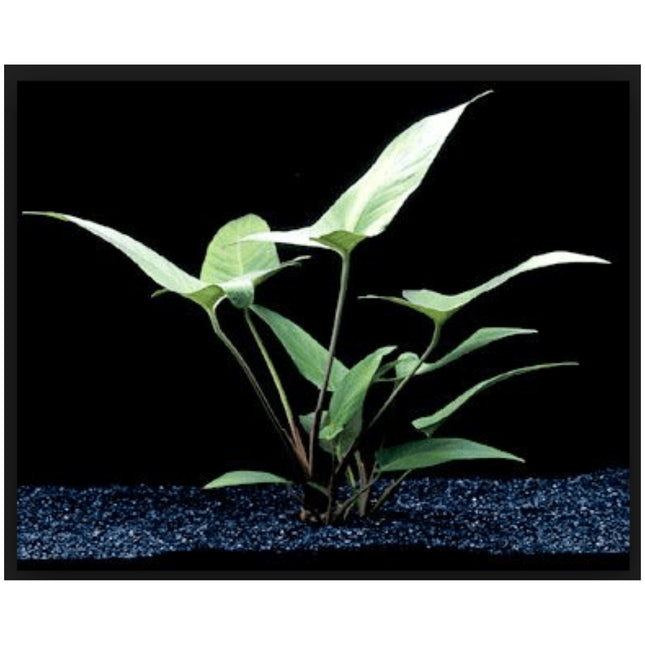
Synonyms: Amauriella hastifolia (Engler) Hepper, Anubias hastifolia var. sublobata Engler, Anubias auriculata Engler, Amauriella auriculata (Engler) Hepper, Anubias haullevilleana De Wildeman, Anubias laurentii De Wildeman, Amauriella obanensis Rendle, Amauriella talbotii RendleLeaves: long heart-shapedLeaf-stem: up to 67 cm longLeaves: up to 33 cm long and 14 cm wide, lateral lobes up to 26 cm long and 8 cm broadHeight in aquarium: 30 – 50 cmOptimal conditions: Temperature: 22 – 27 °CpH: 6.0 – 8.0Water hardness: < 20 dGHPosition in aquarium: middle to backUsual growth rate: 2 – 6 leaves per year
$20.00
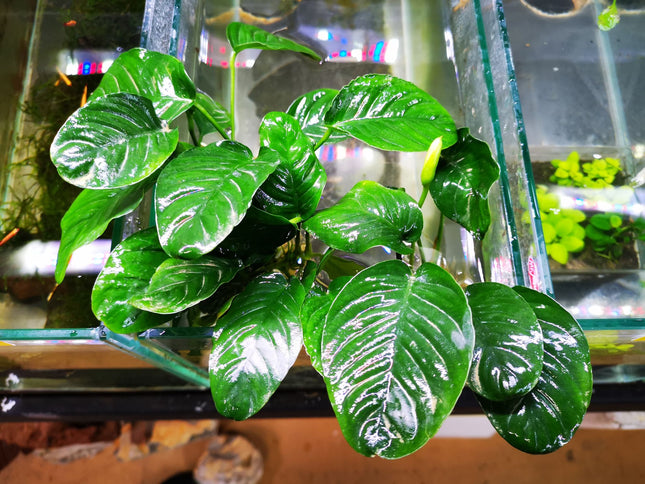
Anubias-jenny is a unique aquatic plant with a unique look. It has beautiful, bright green leaves that are thick and leathery. The leaves grow in a rosette pattern, and they taper to a point. The leaves are also marked with random streaks of white, which makes them stand out from other aquatic plants. Anubias-jenny is also very hardy and can tolerate a wide range of water conditions, making it a great choice for beginner aquarists. It's a slow-growing plant, and it prefers low to moderate lighting. In addition to being an attractive plant, Anubias-jenny also provides a great hiding spot for fish and shrimp.
$49.00
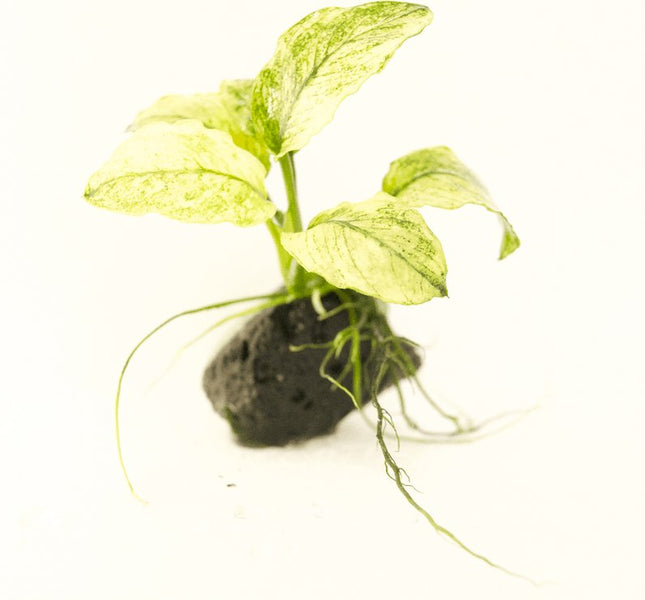
Anubias Nana 'Pinto' is a plant that was derived from the Anubias barteri Nana line. It was discovered in Europe in the 2000s and it got propagated across the world. It is a very easy plant to grow and propagate due to the nature of it's rhizomes. Other varieties that it is included are the white version. Historically this was thought to be a disease and the leaves was cut off the plant to prevent the disease from spreading. However it was later discovered that it was a mutation and thus the plant was propagated. It looks remarkably different from it's nana due to colours of the leaves. What are the requirements? Anubias Nana 'Pinto' requires medium hardness and slightly acidic water at around pH 6.5-7.0. It needs strong lighting however too strong a light may kill the plants so it is advisable to allow only 10 hours of light per day. The plant needs moderate level of fertiliser as well. How High Does it grow? The plant grows to around 2-6 inches or 5-15cm tall. It is naturally a very slow growing plant. How does it grow? Anubias Nana 'pinto' can be grown submersed or it can be grown emersed. PLEASE NOTE THE PLANT VARIATION HERE ARE OF THE PLANT ITSELF
$60.00

Anubias nana bonsai in a pot is an eye-catching and low-maintenance aquatic plant that is perfect for any aquarium. It has small, heart-shaped leaves and a creeping, creeping rhizome that allows it to grow horizontally and hug the sides of an aquarium. This bonsai is an excellent choice for small aquariums due to its slow growth rate and low need for maintenance—all it needs is a few inches of water to keep it happy. Anubias nana bonsai can be placed in the back or sides of an aquarium, where its unique shape and texture will stand out from other plants. It is also a great choice for aquascaping, as its small size allows it to fit in many spaces and its dark green color provides a nice contrast to lighter colored plants.
$19.95
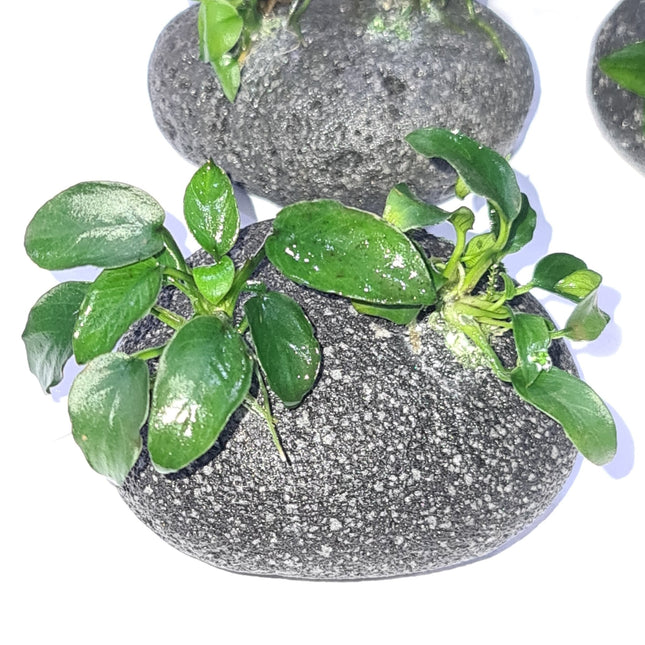
$30.00

Anubias Nana Petite is one of the rarer species of Anubias, this variant has a small leaf structure that makes it an ideal plant for a nano tank. sold as a loose rhizome with several leaves.
$25.00
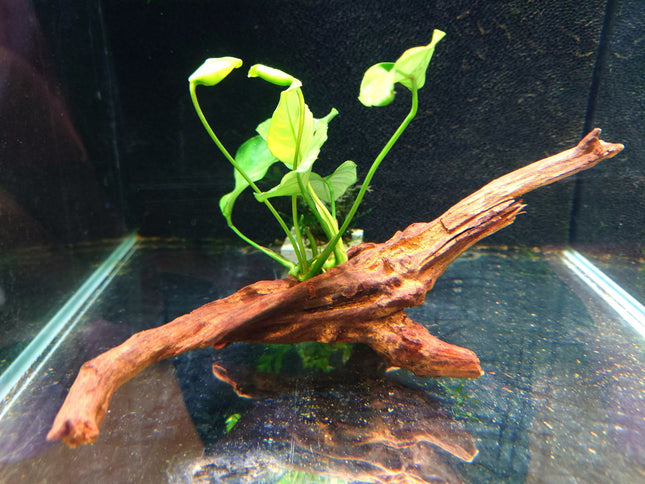
Hand Picked Nano Quan Wood or Dragon Stone with a single Anubias plant attached. Great for tanks less then 30cm Please note that the picture is only indicative. You will get it with more or less leaves.
$29.95
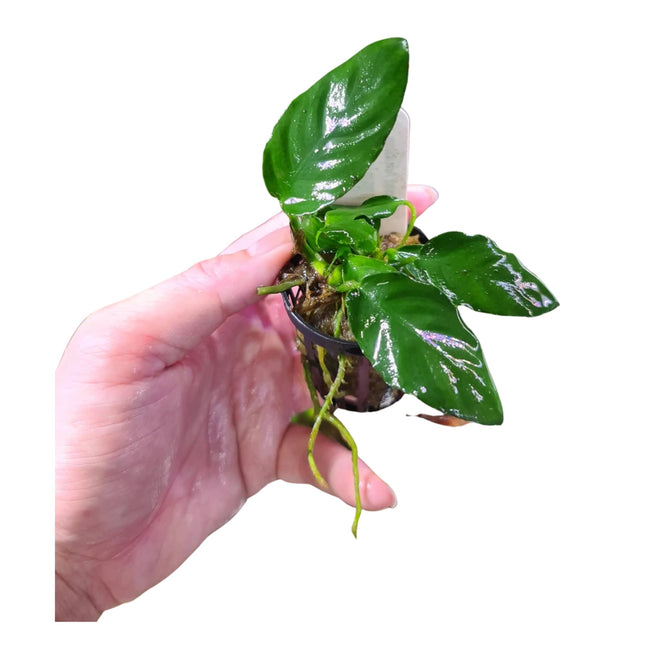
Anubias on Pots are a great addition to any aquarium. Being in a pot has its advantages. When you add your plants to a tank without substrate it doesn't need additional planting. However if you do have other substrates such as Gravel or Sand it can still work. However, for best results it is best to put it in Aquarium Soil or attached to a driftwood.
$25.00
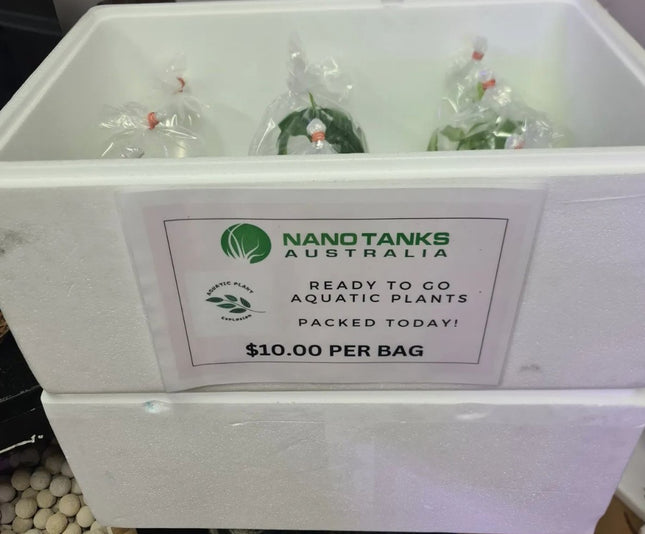
Assorted aquatic plants are a group of plants that are specifically adapted to grow in aquatic environments. These plants can be found in a variety of aquatic ecosystems, including freshwater ponds, streams, rivers, and lakes. Aquatic plants play a crucial role in maintaining the health and balance of aquatic ecosystems by providing oxygen to the water, absorbing excess nutrients, and providing habitat and food for aquatic animals. In the aquarium hobby, aquatic plants are often used to add visual interest and to help maintain good water quality by reducing the amount of harmful nitrogen compounds in the water. Assorted aquatic plants are available in a wide variety of shapes, sizes, and colors. Some of the most common types of aquatic plants include hornwort, Java moss, Anubias, and Cryptocoryne. Each type of plant has its own unique characteristics and requirements for growth, so it's important to research the specific needs of the plants you plan to keep in your aquarium. When keeping assorted aquatic plants in an aquarium, it's important to provide them with the right conditions, including the right type of substrate, adequate light, and the right temperature and water chemistry. In addition, it's important to keep the aquarium well-maintained and to provide regular water changes to ensure that the plants receive the nutrients they need to grow and thrive. Overall, assorted aquatic plants are an important and attractive addition to any aquarium, and they can provide a beautiful and natural underwater environment for your fish and other aquatic animals. Whether you are a seasoned aquarium hobbyist or a beginner, there is sure to be a type of aquatic plant that is right for your aquarium. These plants are packed fresh daily and a great addition for any tank!
$10.00

Aphyosemion Australe Cape Lopez, also known as the Kap Lopez Killifish, is a popular species of freshwater fish that is often kept in aquariums. This fish is native to West Africa, specifically the coastal regions of Gabon, where it inhabits small streams, swamps, and marshes. The Kap Lopez Killifish is a small, colorful fish that can grow up to about 2 inches in length. The males are generally more brightly colored than the females, with vibrant hues of blue, green, and red. The females tend to be a bit duller in color, with shades of brown and yellow. These fish are known for their peaceful temperament and are generally not aggressive towards other fish. They are also relatively easy to care for, as they are hardy and adaptable to a range of water conditions. However, it is important to keep them in a well-maintained aquarium with clean, well-filtered water and plenty of hiding places. In terms of breeding, the Kap Lopez Killifish is a type of annual killifish, which means that they have a short lifespan of only about one year. However, they are prolific breeders and can produce many eggs during their short lifespan. Breeding them requires careful attention to their water conditions, as well as a breeding tank with plenty of plants and hiding places for the fry.
$50.00

(Male Pictured) Aphyosemion Australe Chocolate is a killifish that prefers softer water, but a pH of 6.5 - 7.0 is going to be ideal. These killifish are able to be kept in smaller community setups, some chasing may be present within the species, but given enough space to get away and hide there should not be any other issues.
$80.00

Aphyosemion australe Gold is a type of freshwater fish native to West Africa. It is a member of the Aplocheilidae family and is a member of the Aphyosemion genus. It is an attractive fish with a yellowish-gold body and black stripes along its back and sides. The male has a blue-green head and dorsal fin, while the female has a yellow-orange head and dorsal fin. It prefers slow-moving, heavily-vegetated water bodies. It is an omnivore and feeds on both aquatic and terrestrial insects, crustaceans, and algae. Its maximum size is about 4 inches in length. It is a peaceful fish and can be kept in a community aquarium with other peaceful species.
$50.00

Also known as the two striped killfish, this species is widely-distributed in lowland, coastal regions of Togo, Benin and Nigeria as far as the Cross River delta, and occurs at some inland localities along the lower Niger River. Populations in Cameroon, Equatorial Guinea and Gabon are now considered to represent other species. These beautiful reddish-orange coloured fish are suitable for community tanks with smaller, more peaceful fish like tetras and catfish. A must for any aquarist who love to see streamlined, elongated fish swimming in their community tanks! Sources Aphyosemion bitaeniatum. Seriously Fish. Retrieved 7th September, 2019.
$80.00

Aphyosemion filamentosum is a pair of fish native to the savannas of Central Africa. They are small and colorful, growing to a maximum length of only 2 inches. Their bodies are a deep gold color with small black stripes and they have a single black and white stripe that runs down their back. The fins are yellow and black, and they have a bright yellow tail. Their scales are transparent, allowing a beautiful pattern to be seen. They are peaceful and shy, and prefer to hide in the thick vegetation of their natural habitat. They are omnivorous, feeding on zooplankton, insect larvae, small crustaceans, and plant matter. They are an excellent choice for a peaceful community tank, and will thrive with proper care.
$80.00

Gardneri killifish do well in community aquariums although it is important to keep the fish tank covered at all times, as these fish are prone to jumping. There should be very minimal lighting, and accordingly so, only live plants that can tolerate low light conditions such as crypts (Cryptocoryne sp.) and java moss (Vesicularia dubyana) should be considered. Ideally, the aquarium should be long and have reduced water movement to mimic their natural habitat. Dimorphism: Typically the males will exhibit vivid colors and will be larger than the females. Fecundity: This type of killifish prefers planted aquariums and can lay their eggs on java moss or spawning mops. It is recommended to remove the adults after spawning has been observed or thought to have occurred. Fry will gladly accept live baby brine shrimp. Water Chemistry: 73-79° F, KH 5-8, pH 6.0-7.5.Gold gardneri killifish prefer water that is on the acidic side, so consider supplementing their water with peat moss or driftwood, which can naturally decrease pH. Aquarium Diet: Adult killifish prefer live and frozen foods such as brine shrimp and blood worms, although some will accept dry foods such as flakes and pellets as well. Some killifish can be picky eaters. If this is the case with yours, feed live food and gradually introduce it to dry food as well. Compatibility: Male killifish can be aggressive towards one another. If multiple pairs are being housed, make sure the aquarium is sufficient in size and areas for the killifish to retreat to if they feel threatened. Some other tankmates can include tetra species such as pristella tetras (Pristella maxillaris) or rosy tetras (Hyphessobrycon rosaceus), Corydoras species, and danio species such as the pearl danio (Danio albolineatus).
$40.00

Aphyosemion poliaki is a species of killifish native to Central African Republic, Cameroon, and Equatorial Guinea. This species is part of the Aphyosemion genus, which consists of many different killifish species that are found throughout Africa. Aphyosemion poliaki are a small fish, growing to a maximum adult size of around 2 inches. They have a short, elongated body, with a broad head and bright colors. Males are typically a bright yellow or orange, while females are usually a light grey-brown. Aphyosemion poliaki are an attractive species, and are often kept in aquariums. They are relatively easy to care for, and require a soft substrate such as sand or gravel, as well as plenty of hiding places. They are also an egg-laying species, and will lay their eggs in fine-grained materials such as sand or fine gravel.
$60.00
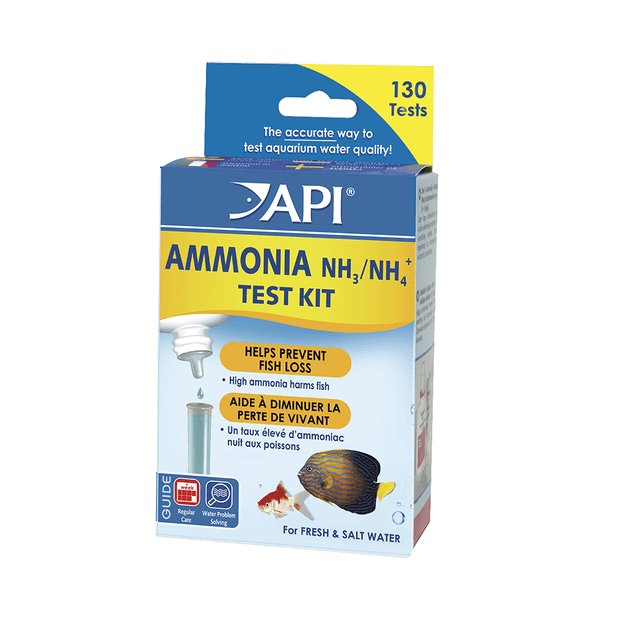
Test your aquarium water and make sure your fish are safe with the API Ammonia Test Kit. This comprehensive kit helps detect low levels of ammonia, which can cause gill damage, lethargy, and death in fish. With its easy-to-use liquid dropper and clear instructions, checking your aquarium water has never been easier.
$34.95
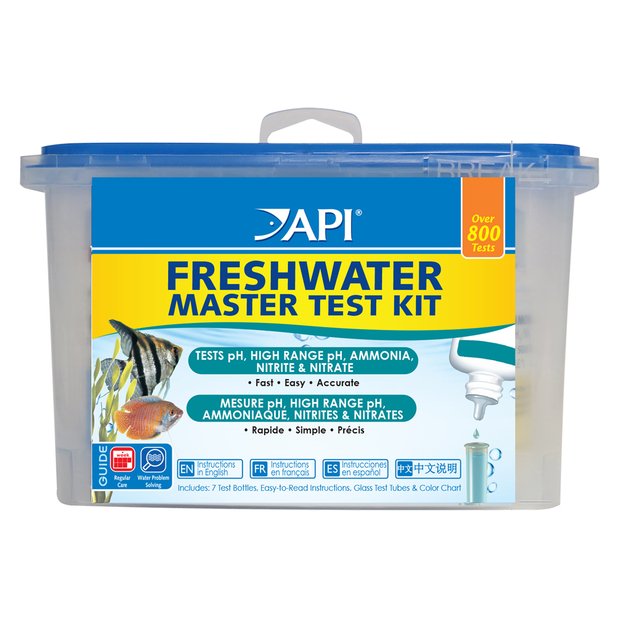
The API Freshwater Master Test Kit provides an accurate, easy-to-use way to test the water in your aquarium. This kit contains high-quality test solutions and a clear color chart for quick results. It helps to detect and monitor pH, ammonia, high-range pH, nitrite, and nitrate to help keep your fish healthy, alert, and active.
$95.95

API KH Hardness Test Kit for Freshwater and Saltwater Aquariums API has been an industry leader in fish care, nutrition, treatments, testing and pond products for over 50 years, giving them a keen insight into your aquarium and its needs - making them the clear choice for fish enthusiasts around the world. The API KH TEST KIT tests fresh or saltwater aquariums for carbonate hardness (KH), and helps monitor water quality and prevent invisible water problems that can be harmful to fish and plants. Carbonate hardness stabilises aquarium pH, and can be used to determine the proper dose of pH buffers. Key Features: Easy to use test kit for measuring carbonate hardness (KH) of the water Helps duplicate the natural habitat of your fish Can be used to determine the proper dose of pH buffers Prevents stress and promotes fish health Suitable for use in freshwater and saltwater aquariums
$14.00
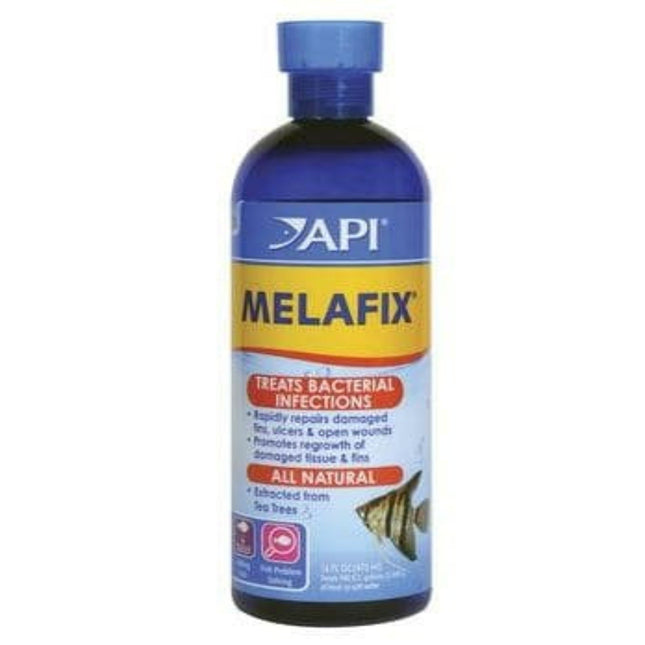
API® Melafix is an all-natural antibacterial treatment that works to treat infections in fish. Common bacterial infections are open wounds and abrasions, tail rot, eye cloud, and mouth fungus. API Melafix also promotes regrowth of damaged fins and tissue. Product may be used when adding fish to an aquarium – particularly to smooth the transition from store to home – and if an infection is suspected, but not yet diagnosed. Some fish bought in pet stores are already carrying diseases at the time of purchase, which may be difficult to detect in its early stages. API Melafix will not adversely affect the biological filter, alter the pH, or discolor water. It is safe for use in freshwater, saltwater, and reef aquariums, and in aquariums with live plants. Dose for the recommended amount of time as directed on label, and in accordance with the size of your aquarium. DIRECTIONS FOR USE: Add 5 ml per 10 gallons of aquarium water. Dose daily for 7 days. After 7 days, make a 25% water change.
$17.00 - $40.00
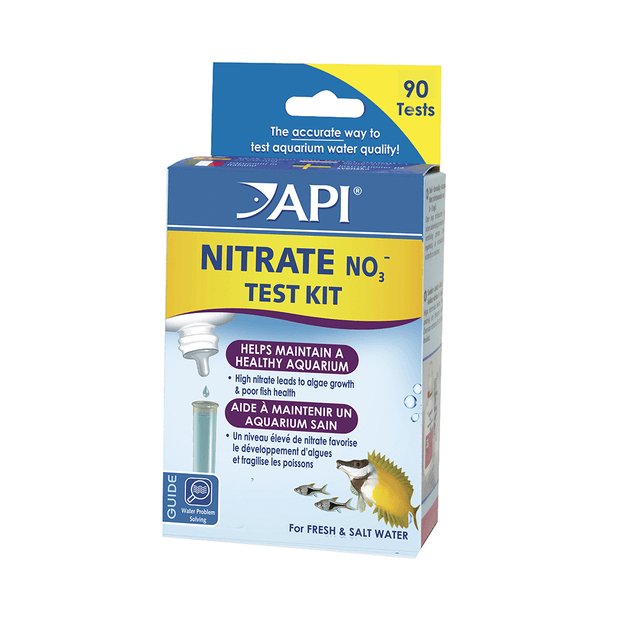
The API Nitrate Test Kit is an accurate and reliable way to measure nitrate levels in fresh and salt water tanks. With its easy-to-use system and precise results, the kit provides a complete and detailed understanding of nitrate concentrations. Rely on it to get the most out of your aquatic environment.
$34.95
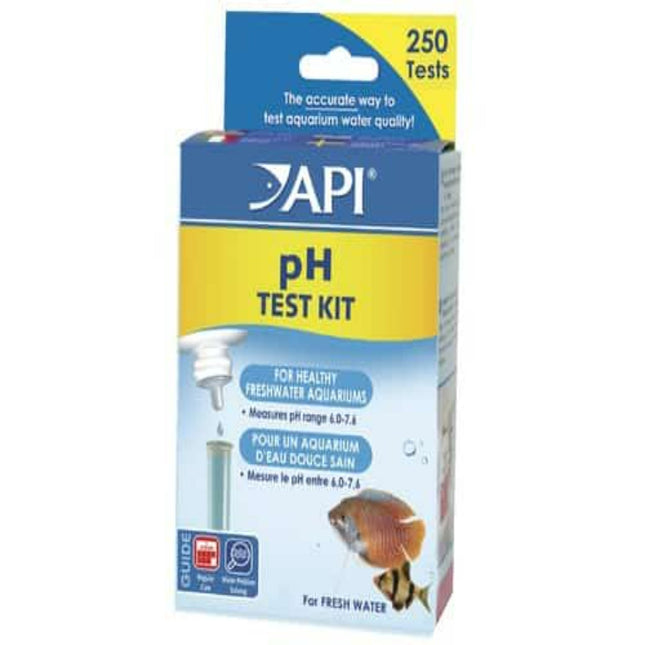
The API pH Test Kit measures a pH range of water from between 6.0-7.6. Fish require a specific pH level to be comfortable. However, pH in an aquarium can change due to fish waste, the addition of tap water and the build-up of natural acids. This easy to use kit accurately measures the pH level and maintains a healthy freshwater community aquarium. Contents The kit has: liquid dropper bottle with safety caps easy-to-read instructions to test and to correct unsafe water conditions colour chart glass test tube with snap-tight cap
$16.95
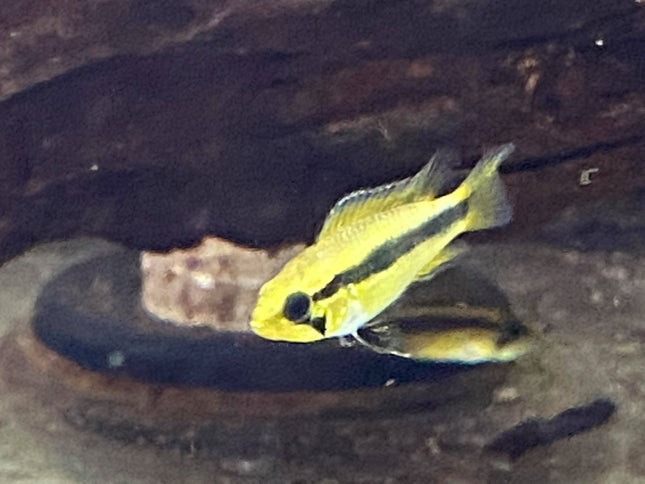
Apistogramma agassizi is a colorful and peaceful freshwater fish from the Cichlidae family. It is native to the Amazon River basin in northern South America. It typically grows to a size of 2.5 to 3 inches in length. The fish has a large, colorful, and eye-catching dorsal fin and a wide, pointed anal fin. The base color of the body is yellow-brown with many vertical black stripes and blue-green markings. This fish is best kept in small groups in an aquarium with plenty of hiding places, open swimming areas, and subdued lighting. They are omnivorous, so they will accept a variety of live, frozen, and flake foods. Apistogramma agassizi is a great choice for the experienced hobbyist looking for a stunning and peaceful addition to their aquarium.
$25.00
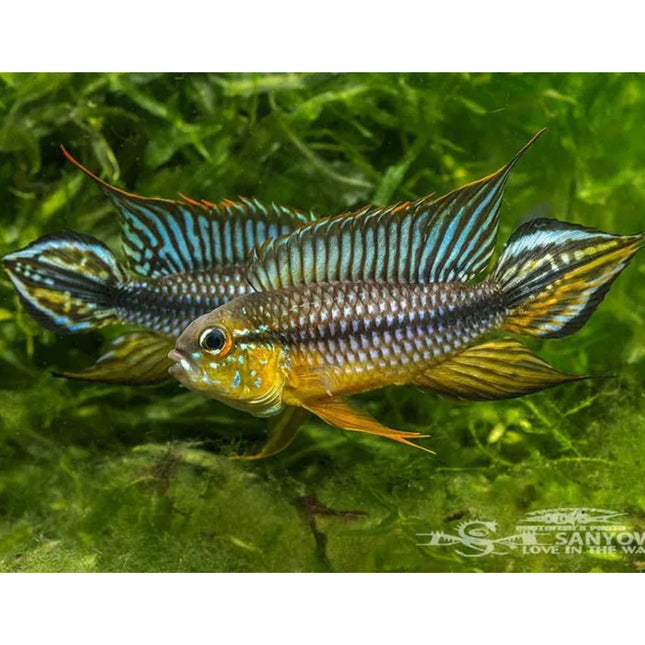
Apistogramma agassizi alenquer pairs are a species of cichlid fish native to the Amazon basin in South America. This species of fish is known for its unique coloration, with males displaying bold black stripes across a bright yellow body, while the females are a more muted yellow-brown hue. They are usually found in pairs and are relatively peaceful, making them an ideal choice for community aquariums. They do best in tanks with plenty of hiding places and a sandy substrate, and should be provided with plenty of vegetation for grazing. They can grow up to 4 inches in length and live for up to five years, making them an interesting and long-lasting addition to any aquarium.
$70.00
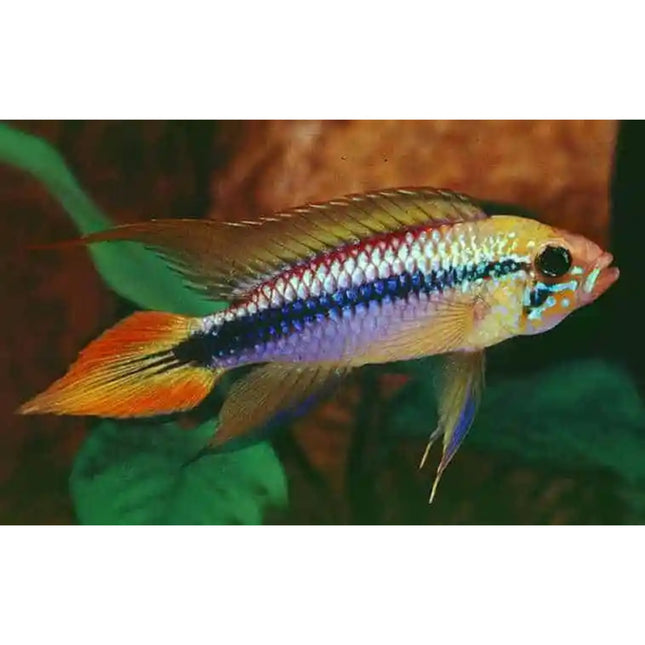
The Apistogramma agassizi double red male is a striking fish native to South America. It has a beautiful red coloration with a deep black stripe running along its back. Its fins are a lighter shade of red, giving it a unique look. It can reach up to 4 inches in length and is an omnivore, eating a variety of foods including small crustaceans, worms, and insects. This fish is an excellent choice for the experienced aquarist due to its peaceful nature and its ability to thrive in a well-maintained aquarium.
$140.00
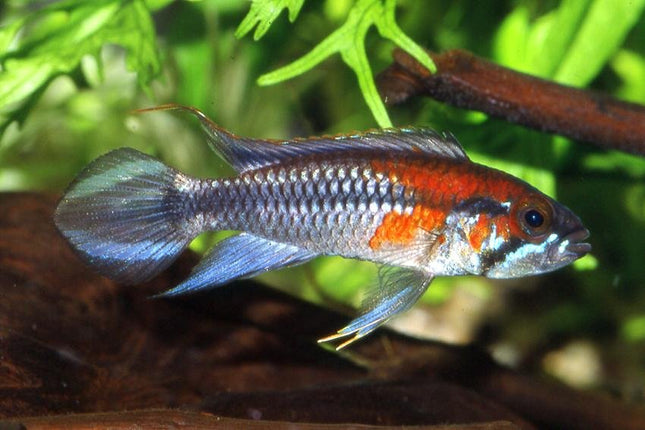
Apistogramma agassizi-santarem is a species of dwarf cichlid native to South America. It is a beautifully colored fish with a bright yellow body and black markings on the face and fins. Males have a deep red or orange band across the front of their body, while females are more drab in color. This species is relatively peaceful and can be kept in a community aquarium. They prefer well-oxygenated water with a pH of 6.5-7.5 and temperatures of 72-79°F (22-26°C). It is important to provide plenty of hiding spaces and a sandy substrate for them to dig in. They are carnivorous and will readily accept a variety of live and frozen foods. Apistogramma agassizi-santarem is an egg-scattering species, and can be bred in the home aquarium.
$80.00
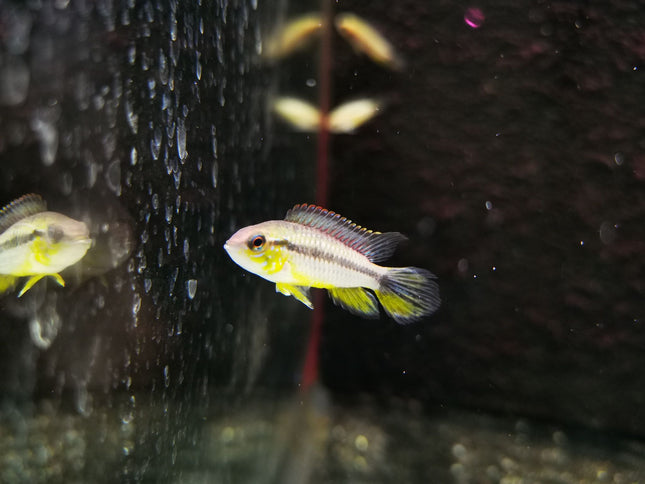
Apistogramma agassizi 'Tefe Pearl Blue' is a stunning and vibrant freshwater fish from South America. It has a beautiful blue body with an orange/yellow head and tail, along with pearl-colored spots. It is a peaceful fish that prefers to live in a well-planted aquarium, with plenty of hiding places and driftwood for them to feel secure. It loves to swim in schools and will show off its vibrant colors when kept in a group. It is an ideal fish for those just starting out in the hobby and is easy to care for.
$90.00
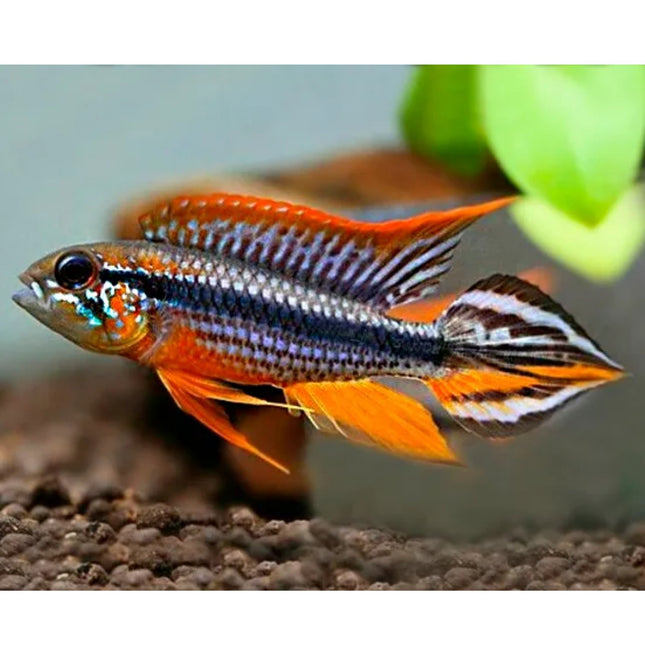
Apistogramma agassizi tefe red back is a species of small cichlid from South America. It has a bright red-orange stripe across its back and a blue-green body. The fins are transparent and the tail has a yellow-orange hue. It is a peaceful fish and can be kept with other small, peaceful fish. It prefers a well-planted aquarium with plenty of hiding spots. The water should be soft and slightly acidic and it should be fed a variety of live and frozen foods. This species is relatively easy to breed in captivity and can often be seen fanning eggs in the aquarium.
$80.00
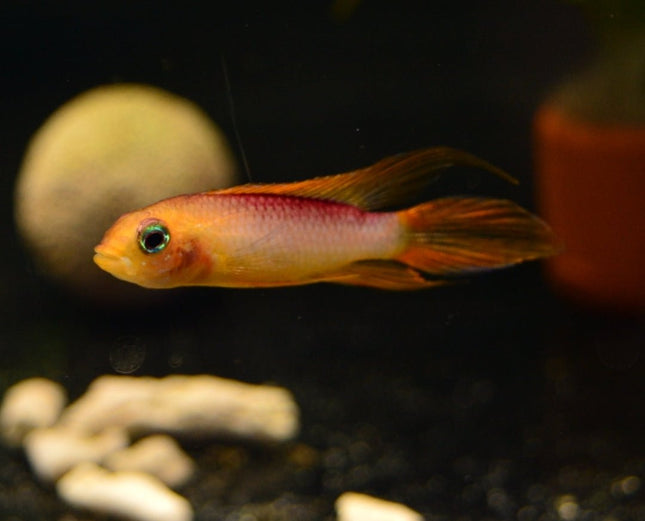
Apistogramma Agassizii Fire Gold is a beautiful and colorful fish species native to South America. It is a small cichlid that grows to a maximum length of about 2.8 inches. It has a vibrant red-orange base color with a yellow-gold shimmer on its sides, giving it its name. It also has a black stripe running from its snout to the base of its tail, and its fins are outlined in a bright blue. This species is a very peaceful fish that prefers slow-moving, heavily-planted aquariums with plenty of hiding places. It is an omnivore and can be fed a variety of foods such as live and frozen foods, flakes, and pellets. This species is a great addition to any community aquarium and is sure to add a splash of color to any tank.
$60.00
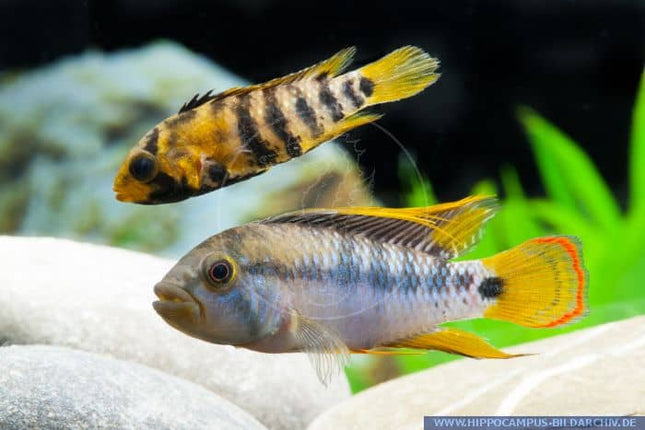
Apistogramma Baenschi sp. Inka 50 is an incredibly vibrant and colorful freshwater fish native to the Amazon River basin in South America. This fish is a member of the Apistogramma family, which includes some of the most sought after and beautifully colored cichlids. These fish are known for their bright yellow and orange body with dramatic black stripes, and they can reach up to 5 inches in length when fully grown. Apistogramma Baenschi sp. Inka 50 is a peaceful species that can be kept in a community tank with other fish of similar size and temperament. This species is relatively easy to care for and is suitable for any aquarist with a bit of fishkeeping experience. The price for Apistogramma Baenschi sp. Inka 50 is $30 per fish.
$65.00
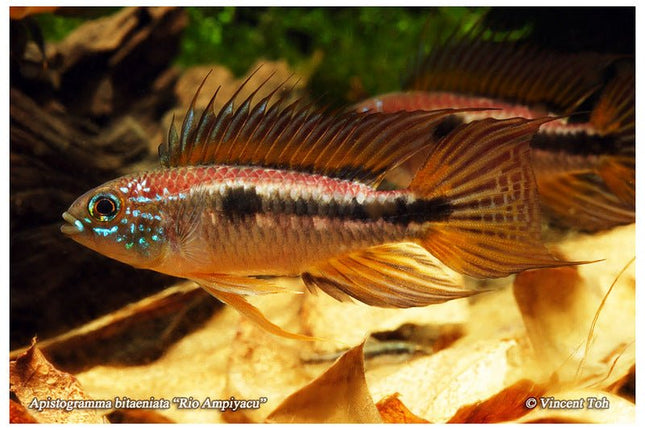
Apistogramma bitaeniata is a small, colorful fish native to South America. It is a member of the Cichlidae family and is also known as the False Pterophyllum. This fish is typically found in slow-moving rivers and streams, and in the deeper areas of lakes. It is a territorial species, with males defending their territories against other males and females. Apistogramma-bitaeniata grows up to 3.4 inches in length, and is typically brown and yellow with a unique pattern of stripes, spots, and blotches. They are omnivorous and feed on a variety of insects, crustaceans, worms, and plant matter. This fish is popular in the aquarium trade and is ideal for those who have a planted tank.
$150.00

Apistogramma BITAENIATA SHISHITA, a beautiful freshwater fish. With its vibrant colors and unique markings, this species is a popular choice for aquarium enthusiasts. With its peaceful nature and expert adaptability, it's the perfect addition to any aquatic environment.
$60.00
You have seen 72 out of 1934 products